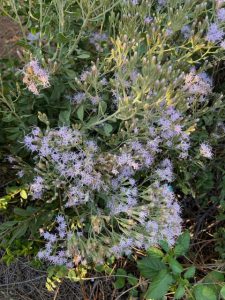Plants and turf in Central Florida landscapes go dormant in the fall. Flowers, bark, and foliage makes a fall-to-winter garden showier when the temperature cools! There are some native and non-native plants which may add some interest to Central Florida landscapes or gardens!
Garbaria

Garberia heterophylla has gray-green foliage that you may enjoy in your garden. This native plant is found in the Native Plant Garden of the UF/IFAS Sumter County Demonstration Garden. Volunteers added more Garberia plants with the Florida Wildflower Grant which we installed in December of 2020. While this shrubby perennial could grow up to four to eight feet, the planting in the demo garden mays perhaps up to 3 feet tall. The main plant has been there for several years. It blooms early fall with a lovely pinkish-lavender cluster of blooms that are wonderfully dramatic. By far one of the favorites in the Demo Garden garden, and it would be a lovely mass of fall blooms in any garden.
Mahonia

A wonderful shade-loving evergreen is Mahonia ‘Soft Caress.’ While Oregon Grape Holly (Mahonia bealii) with its stiff, pointy leaves is blessed with wonderfully fragrant flowers in the winter, the Soft Caress Mahonia is softer and much shorter. It has thinner, flexible leaves, and the plants are perhaps three feet tall and wider, perhaps 3 1/2 feet. They also have those lovely yellow blooms, although smaller, and no fragrance is noted. It is truly lovely planted in shade areas in masses. No disease or insect problems are observed, although lubber grasshoppers (an annual nemesis) seem to like it, but not enough to eat the whole thing to the ground!
Natchez Crape Myrtle
Natchez Crape Myrtle a dramatic crape myrtle although may not be for everyone because they can reach up to 30 feet tall. This non-native species has a lovely arching habit and can bloom from late spring into the summer. If you prune off some of the berries resulting from the beautiful white flower panicles (a collection of blooms), it can create additional blooms. So, the winter aspect of the Natchez crape myrtle is the bark! All crape myrtles have lovely bark especially when not cut back by homeowners or landscapers. But Natchez has a creamy bark with a cinnamon red underneath so if you choose this one, don’t let anyone cut it back! If Natchez is too large, check out other options at https://edis.ifas.ufl.edu/pdf%5Carchived%5CMG%5CMG266%5CMG266-11435.pdf . This archived publication has a list of crape myrtles from very large to dwarf which will fit in any garden.
Muhlygrass
Look for the misty pink ethereal displays of Muhlygrass flowers in plantings in the fall (Muhlenbergia capillaris). This native grass is a wonderfully neat grass in the

landscape throughout the year and erupts with those lovely blooms held up over the grass. The Muhlygrass in the demo garden is perhaps three feet tall and wide. Prune them back in the spring, if desired. Muhlygrass is lovely in masses in full sun. There is a white flowering variety if “misty ethereal pink” does not work!
This is just a taste of plants to enjoy for a fall to winter garden. For more information on plants for fall, consider bedding plants, bulbs, and herbs visit the UF/IFAS Central Florida Gardening Calendar at https://edis.ifas.ufl.edu/publication/EP450. Enjoy your fall garden!
 0
0
